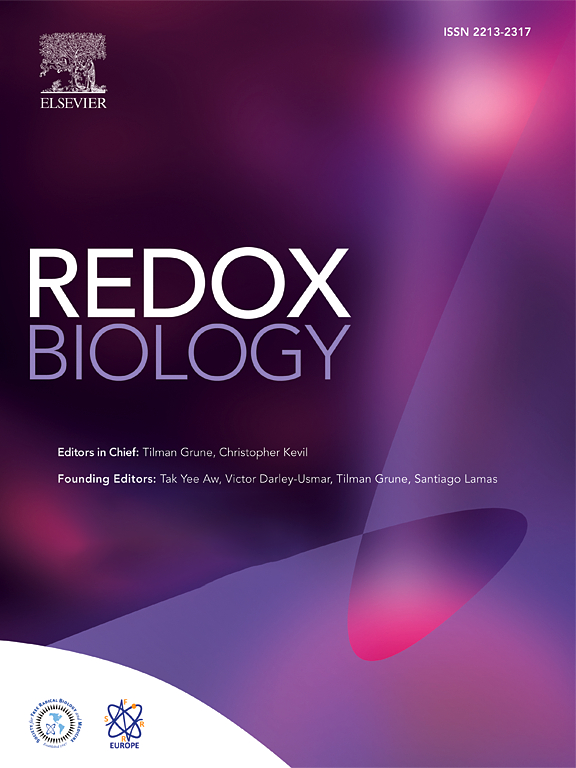Muscle-derived factor alleviated cognitive impairment caused by intestinal ischemia-reperfusion
IF 10.7
1区 生物学
Q1 BIOCHEMISTRY & MOLECULAR BIOLOGY
引用次数: 0
Abstract
Intestinal ischemia/reperfusion (II/R) is a common and grave clinical event, with high morbidity and mortality which can cause cerebral dysfunctions. There are no ideal prevention and treatment measures yet. The present study aimed to determine whether muscle-derived factors can alleviate gut-associated cerebral dysfunctions (GACD) following II/R. We measured the tibialis anterior muscle thickness and irisin levels in patients with and without cognitive dysfunction following cardiopulmonary bypass surgery, calculating the correlation between irisin and cognitive impairment. We found that this protective effect is related to muscle-derived irisin. To elucidate the role of irisin in improving GACD, we knocked out FNDC5 to deplete endogenous irisin and supplemented exogenous irisin. Mechanistic insights into irisin's effects on GACD were investigated using in vivo and in vitro models, incorporating techniques such as transmission electron microscopy, protein docking analysis, gene overexpression, and western blotting. FNDC5/irisin deficiency aggravated cognitive impairments, the pro-inflammation microglia activation, oxidative injury, inflammatory response, neuronal apoptosis and ferroptosis, while recombinant FNDC5/irisin reversed the above changes leading to neurostructural and cognition recovery. Mechanistically, thioredoxin-interacting protein (TXNIP) was activated in the II/R-related neuropathology and was deteriorated in FNDC5/irisin knockout mice. Our results highlight the potential of FNDC5/irisin to slow GACD, providing new insights and potential therapeutic strategies for the prevention and treatment of GACD.
肌源性因子减轻肠缺血再灌注所致认知功能障碍
肠缺血/再灌注(II/R)是一种常见且严重的临床事件,发病率和死亡率高,可引起脑功能障碍。目前尚无理想的预防和治疗措施。本研究旨在确定肌肉源性因子是否可以减轻II/R后肠相关脑功能障碍(GACD)。我们测量了体外循环术后有和无认知功能障碍患者的胫骨前肌厚度和鸢尾素水平,计算鸢尾素与认知功能障碍之间的相关性。我们发现这种保护作用与肌肉来源的鸢尾素有关。为了阐明鸢尾素在改善GACD中的作用,我们敲除FNDC5以消耗内源性鸢尾素,补充外源性鸢尾素。利用体内和体外模型,结合透射电镜、蛋白对接分析、基因过表达和western blotting等技术,研究了鸢尾素对GACD的作用机制。缺乏FNDC5/鸢尾素可加重认知障碍、促炎小胶质细胞活化、氧化损伤、炎症反应、神经元凋亡和铁凋亡,而重组FNDC5/鸢尾素可逆转上述变化,导致神经结构和认知功能恢复。在机制上,硫氧还蛋白相互作用蛋白(TXNIP)在II/ r相关神经病理中被激活,并在FNDC5/鸢尾素敲除小鼠中恶化。我们的研究结果突出了FNDC5/鸢尾素减缓GACD的潜力,为预防和治疗GACD提供了新的见解和潜在的治疗策略。
本文章由计算机程序翻译,如有差异,请以英文原文为准。
求助全文
约1分钟内获得全文
求助全文
来源期刊

Redox Biology
BIOCHEMISTRY & MOLECULAR BIOLOGY-
CiteScore
19.90
自引率
3.50%
发文量
318
审稿时长
25 days
期刊介绍:
Redox Biology is the official journal of the Society for Redox Biology and Medicine and the Society for Free Radical Research-Europe. It is also affiliated with the International Society for Free Radical Research (SFRRI). This journal serves as a platform for publishing pioneering research, innovative methods, and comprehensive review articles in the field of redox biology, encompassing both health and disease.
Redox Biology welcomes various forms of contributions, including research articles (short or full communications), methods, mini-reviews, and commentaries. Through its diverse range of published content, Redox Biology aims to foster advancements and insights in the understanding of redox biology and its implications.
 求助内容:
求助内容: 应助结果提醒方式:
应助结果提醒方式:


